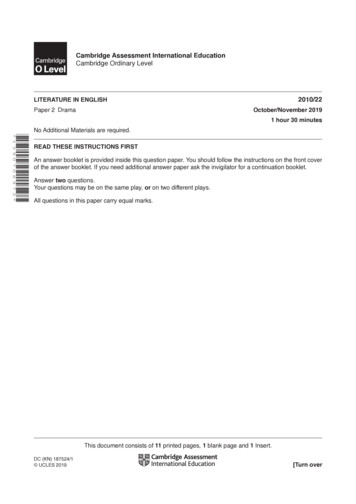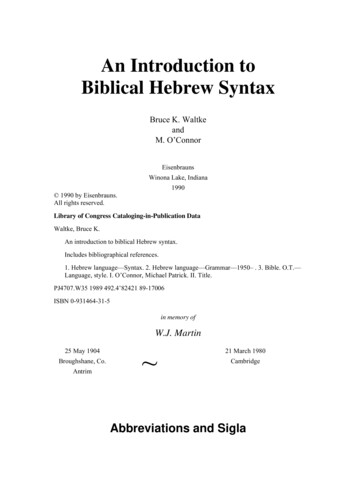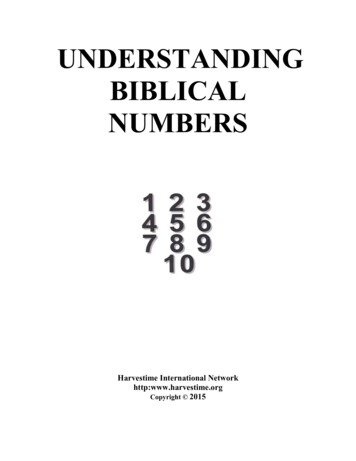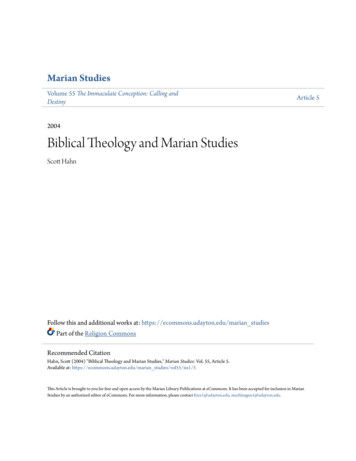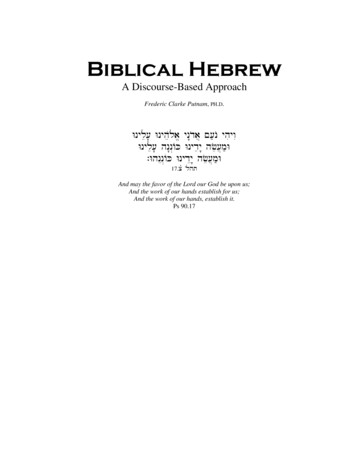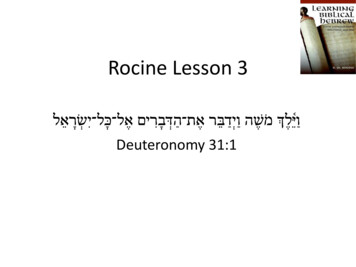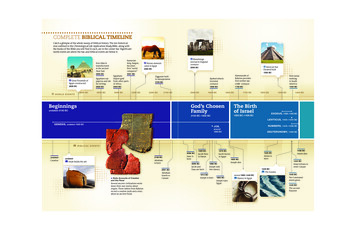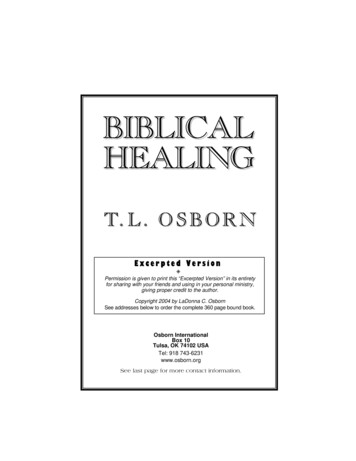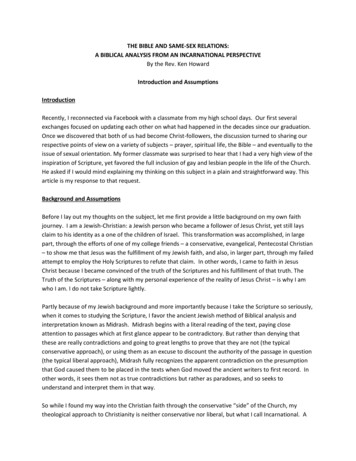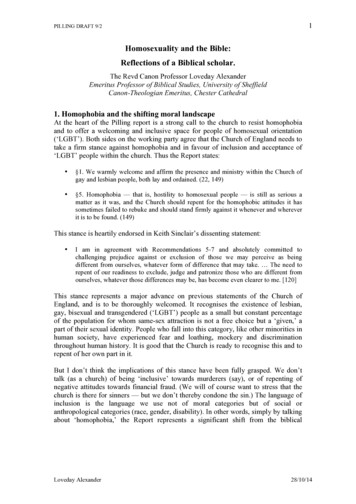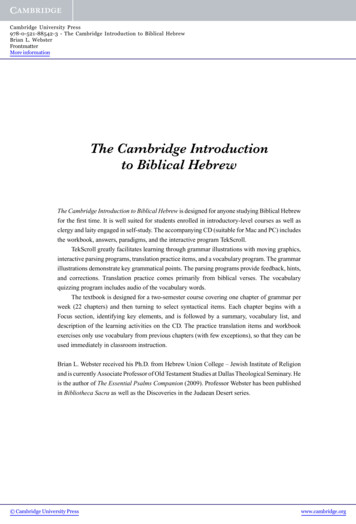
Transcription
Cambridge University Press978-0-521-88542-3 - The Cambridge Introduction to Biblical HebrewBrian L. WebsterFrontmatterMore informationThe Cambridge Introductionto Biblical HebrewThe Cambridge Introduction to Biblical Hebrew is designed for anyone studying Biblical Hebrewfor the first time. It is well suited for students enrolled in introductory-level courses as well asclergy and laity engaged in self-study. The accompanying CD (suitable for Mac and PC) includesthe workbook, answers, paradigms, and the interactive program TekScroll.TekScroll greatly facilitates learning through grammar illustrations with moving graphics,interactive parsing programs, translation practice items, and a vocabulary program. The grammarillustrations demonstrate key grammatical points. The parsing programs provide feedback, hints,and corrections. Translation practice comes primarily from biblical verses. The vocabularyquizzing program includes audio of the vocabulary words.The textbook is designed for a two-semester course covering one chapter of grammar perweek (22 chapters) and then turning to select syntactical items. Each chapter begins with aFocus section, identifying key elements, and is followed by a summary, vocabulary list, anddescription of the learning activities on the CD. The practice translation items and workbookexercises only use vocabulary from previous chapters (with few exceptions), so that they can beused immediately in classroom instruction.Brian L. Webster received his Ph.D. from Hebrew Union College – Jewish Institute of Religionand is currently Associate Professor of Old Testament Studies at Dallas Theological Seminary. Heis the author of The Essential Psalms Companion (2009). Professor Webster has been publishedin Bibliotheca Sacra as well as the Discoveries in the Judaean Desert series. Cambridge University Presswww.cambridge.org
Cambridge University Press978-0-521-88542-3 - The Cambridge Introduction to Biblical HebrewBrian L. WebsterFrontmatterMore informationThe Cambridge Introductionto Biblical HebrewBrian L. WebsterDallas Theological Seminary Cambridge University Presswww.cambridge.org
Cambridge University Press978-0-521-88542-3 - The Cambridge Introduction to Biblical HebrewBrian L. WebsterFrontmatterMore informationCAMBRIDGE UNIVERSITY PRESSCambridge, New York, Melbourne, Madrid, Cape Town, Singapore, São Paulo, DelhiCambridge University Press32 Avenue of the Americas, New York, NY 10013-2473, USAwww.cambridge.orgInformation on this title: www.cambridge.org/9780521712842 C Brian L. Webster 2009This publication is in copyright. Subject to statutory exceptionand to the provisions of relevant collective licensing agreements,no reproduction of any part may take place without the writtenpermission of Cambridge University Press.First published 2009Printed in the United States of AmericaA catalog record for this publication is available from the British Library.Library of Congress Cataloging in Publication dataWebster, Brian L., 1965–The Cambridge introduction to biblical Hebrew : with CD-ROM / Brian L. Webster.p.cm.ISBN 978-0-521-88542-3 (hardback) – ISBN 978-0-521-71284-2 (paperback)1. Hebrew language – Grammar – Textbooks.exercises, etc.2. Hebrew language – Grammar – Problems,3. Bible O.T. – Language, style. I. Title.PJ4567.3.W357 492.4 82421–dc2220092008062326ISBN 978-0-521-88542-3 hardbackISBN 978-0-521-71284-2 paperbackCambridge University Press has no responsibility for the persistence oraccuracy of URLs for external or third-party Internet Web sites referred to inthis publication and does not guarantee that any content on such Web sites is,or will remain, accurate or appropriate. Information regarding prices, traveltimetables, and other factual information given in this work are correct atthe time of first printing, but Cambridge University Press does not guaranteethe accuracy of such information thereafter. Cambridge University Presswww.cambridge.org
Cambridge University Press978-0-521-88542-3 - The Cambridge Introduction to Biblical HebrewBrian L. WebsterFrontmatterMore informationContentsAcknowledgmentsIntroduction1The Signs and Sounds of Hebrew: Orthography and Pronunciation2Syllables: The Structural Girders of Hebrew3Nouns Part One: Gender, Number, State4Nouns Part Two: More Noun Patterns5Prepositions, Conjunction, Article, Interrogative, Direct Object6Pronouns, Pronominal Suffixes on Substantives and Prepositions7Adjectives8Participles, Infinitive Construct9Selected Words, Numbers10Introduction to Verbs; Qal Perfect11Qal Perfect: Weak Verbs12Qal Imperfect and Preterite: Strong Verbs13Qal Imperfect and Preterite: Weak Verbs14Qal Volitional Forms, Infinitive Absolute15Pronominal Suffixes on Verbs16Derived Stems: Infinitives and Participles17I-class Imperfects: Niphal, Piel, Hitpael, Hiphil18I-class Imperfects: R3 Weak, R2 G, R1 G, R2 n, R1 n19I-class Imperfects: R2 y/ w, R1 y/ w, R2 R3; Weak Imv., Inf., & Ptc.20A-class Imperfects: Pual, Hophal21Derived Stems: Perfects: Strong Verbs, R3 Weak22Derived Stems: Perfects: R1 Weak, R2 Weak, R2 R3; Rare StemsExcursus ASorting through Forms: Stem ID Badges and Alias ProfilesExcursus BIntroduction to Chapters 23–32: A Syntax Sampler23Pauses and Drama24Lexicography: Semantic Combinations and the Meaning of dqp25Noun Syntax26Verb Syntax: The Piel27Verb Syntax: Participles28Clausal Syntax in Narrative; Movies in the Mind29Particles rv,a} and hNEhi30Verb Syntax: Infinitives31Verb Syntax: Perfect and Vav plus Perfect32Poetry and Time FrameAppendix AAdditional Vocabulary ListsAppendix BGlossaryAppendix CParadigms, Verb ID Badges, Alias 79289295307315333347v Cambridge University Presswww.cambridge.org
Cambridge University Press978-0-521-88542-3 - The Cambridge Introduction to Biblical HebrewBrian L. WebsterFrontmatterMore informationAcknowledgmentsI would like to thank the Hebrew Union College – Jewish Institute of Religionand their faculty for their training in Hebrew and in the languages and history of theAncient Near East. I am grateful for the opportunity to have studied under suchsensitive readers of ancient texts and models of methodology. I would like tospecially thank the members of my examining committee, Drs. Alan Cooper, SamuelGreengus, and David Weisberg, for their encouragement during my studies and after.I am particularly thankful to Isaac Jerusalmi for his influence in approachingmorphology. Dr. Jerusalmi teaches the structure of Hebrew morphology with greatenthusiasm and I consider his teaching a key inspiration in the planning of thisproject.I am also particularly thankful to Stephen Kaufman for his influence on myunderstanding of Hebrew syntax. His mastery of Semitic languages, not simply ofgrammars and theories but of the behaviors of real texts, has been a wellspring forteaching Hebrew.Statistical information, such as word frequency counts, is generally taken fromAccordance 6.8, OakTree Software, Inc., 2005.The NewJerusalem, ScriptHebrewII, and TranslitLS fonts used in this work areavailable from Linguist’s Software Inc., www.linguistsoftware.com. My thanks toPhil Payne and staff for customizing the NewJerusalem font with a few specialcharacters. My compliments on the fonts’ appearance and ability to work in theapplications required to put these materials together.The portable document files (PDFs) on the CD were made with Adobe Acrobat,and the interactive content was done in Flash; both are programs of Adobe (seewww.adobe.com).Thanks to my students who have offered suggestions and corrections.Thanks to Robert B. Chisholm and Bill T. Arnold for their encouragement andsupport.Thanks to John Dyer for timely advice on programming the CD.My deepest thanks for their patience and encouragement go to my wife Hope anddaughters Angela, Lily, Robyn, and Starla.vii Cambridge University Presswww.cambridge.org
Cambridge University Press978-0-521-88542-3 - The Cambridge Introduction to Biblical HebrewBrian L. WebsterFrontmatterMore informationIntroductionThe English alphabet can be traced to the Greek alphabet, which in turn can betraced through the Phoenicians to that also used by the Hebrews. One thing theGreeks did was to start writing backwards, reversing the direction of writing to gofrom left to right. Hebrew is written from right to left.The Greeks also added vowels. The Jews and their neighbors wrote onlyconsonants. Because of the nature of Hebrew, writing only the consonants issufficient to read it – for people who already know the language. But, as vowels areindeed helpful, the scribes later added vowel signs and other marks, solidifying thereading tradition and the text. These vowel signs were added below and sometimesabove or within the consonants.After adjusting to the different looks of the writing, we will find things morefamiliar. It may initially feel odd to read Hebrew, but you can do it. Considering thatyou have been successfully reading backwards (left to right) for years, you will dofine reading Hebrew frontward (right to left).Besides the writing system, Hebrew spellings primarily involve the following:10 noun endings,20 verb endings and/or prefixes,11 main verb stem and infinitive patterns (for 7 stems),3 participle indicators, and15 or so basic pronominal suffix forms (depending on how you count).In addition to those 59 basic spelling items, there are7 syllable principles and5 special consonant principles.There are still many vocabulary words to learn and matters of syntax to master.But these 71 basic forms and principles combine and recombine to form the vastmajority of all Hebrew words. The trick is in recognizing the combinations. Youroverall workload is reduced if you can see it as a small number of morphologicalpieces responding to a couple of handfuls of syllable principles and deviantconsonants.Knowing those pieces is your passageway to reading Hebrew. And readingHebrew opens your access to the Bible.ix Cambridge University Presswww.cambridge.org
Cambridge University Press978-0-521-88542-3 - The Cambridge Introduction to Biblical HebrewBrian L. WebsterFrontmatterMore informationxIntroductionA Book and CD Package.The book and accompanying CD are closely integrated. You could think of themas a CD with an accompanying book just as well as a book with a CD. The CD hasthe Workbook, the Workbook Answers, and Paradigms in PDF documents. Inaddition, it contains the interactive program TekScroll to help you learn Hebrew.TekScroll includes several Learning Activities, including Practice Readings,Parsing Programs, a Vocabulary Program, and Grammar Illustrations. The role theseplay is described in more detail later in the Introduction. But the basic elements andhow to interact with them are described here.After loading, an index appears on the left side of the “book” on the screen. Clickon the chapter number or its abbreviated title to get the menu of Learning Activitiesfor that chapter. You can also go right to the vocabulary program by clicking thearrow at the bottom left of the page. After you select a chapter from the index, itsmenu appears on the right. The Learning Activities (abbreviated LA) that are part ofTekScroll have an arrow button; the others are in the Workbook. The list of LearningActivities is repeated from the end of the chapters in the grammar. Cambridge University Presswww.cambridge.org
Cambridge University Press978-0-521-88542-3 - The Cambridge Introduction to Biblical HebrewBrian L. WebsterFrontmatterMore informationIntroductionxiPractice Readings.The Practice Readings first present a Hebrew selection, usually a Bible verse,along with its number in the set, in this case reading number 1 of 75. After trying toread it, you can click to see the translation.Typically, the Practice Readings only use the vocabulary from previous chapters(not the current chapter) and use the last chapter’s vocabulary a minimum of threetimes. Thebutton in the lower left returns you to the chapter index.The oil lamp Navigation buttons take you through thereadings either in order, “Prev(ious)” or “Next,” or“Random(ly)”. Clicking any of the navigation buttons willshow the translation. They only move you on to another reading item if the translationis already showing.To go to a particular practice reading, which is useful if you wantto ask a question about one of them, type in the item number onthe line after “Go to ” and then click on the quill and inkwell to the right of the line. Cambridge University Presswww.cambridge.org
Cambridge University Press978-0-521-88542-3 - The Cambridge Introduction to Biblical HebrewBrian L. WebsterFrontmatterMore informationxiiIntroductionPractice Reading variants.In the later chapters, the Practice Readings are combined with the ParsingProgram (see below) so that verbs are parsed from context.The first two chapters have readings on a different background due to differentnavigation concerns. Different reading lists are chosen from the menu on the left. TheNavigation buttons move you through whichever list you have chosen. Cambridge University Presswww.cambridge.org
Cambridge University Press978-0-521-88542-3 - The Cambridge Introduction to Biblical HebrewBrian L. WebsterFrontmatterMore informationIntroductionxiiiParsing Programs.The noun and verb parsing programs look very similar. The word to be parsed isthe Specimen in the center. Enter your answers in the row of boxes directly below thespecimen. The answer for Root, right center, must be typed in from the Enter Rootkeypad. (You must use appropriate final forms of the consonants. / and W are onlyused for verb roots with a w for the second root letter.) The other answers can bechosen from the dropdown menus or they can be typed in, but must be typed exactly.The Show Answer button reveals the answers in the row of black boxes directlybelow the answers that you entered. The Check Answer button will confirm thec
the Workbook, the Workbook Answers, and Paradigms in PDF documents. In addition, it contains the interactive program TekScroll to help you learn Hebrew. TekScroll includes several Learning Activities, including Practice Readings, Parsing Programs, a Vocabulary Program, and Grammar Illustrations. The role these play is described in more detail later in the Introduction. But the basic
